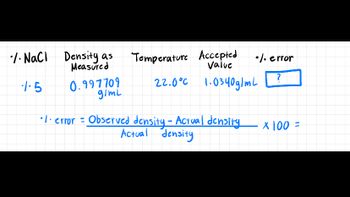
Chemistry
10th Edition
ISBN: 9781305957404
Author: Steven S. Zumdahl, Susan A. Zumdahl, Donald J. DeCoste
Publisher: Cengage Learning
expand_more
expand_more
format_list_bulleted
Question
thumb_up100%
How do I obtain the correct number of sig figs and how do I calculate it using the given formula.

Transcribed Image Text:•/. NaCl Density as
Measured
1.5
0.997709
g/mL
Temperature Accepted
value
•/. error
?
22.0°C 1.0340g/mL
•1• error = Observed density - Actual density x 100 =
Actual density
Expert Solution
This question has been solved!
Explore an expertly crafted, step-by-step solution for a thorough understanding of key concepts.
This is a popular solution
Trending nowThis is a popular solution!
Step by stepSolved in 2 steps with 2 images

Knowledge Booster
Learn more about
Need a deep-dive on the concept behind this application? Look no further. Learn more about this topic, chemistry and related others by exploring similar questions and additional content below.Similar questions
- Which of the following are exothermic reactions and which are endothermic? (a) the burning of methane O exothermic O endothermic (b) the explosion of dynamite O exothermic endothermic (c) the combination of zinc and sulfur to form zinc sulfide O exothermic O endothermic (d) the burning of iron in chlorine O exothermic endothermic (e) the neutralization of a strong acid by a strong base O exothermic endothermic (f) the burning of methane O exothermic O endothermicarrow_forwardConsider the following chemical reaction HCl (aq) + HgNO3 (aq) à Hg2Cl2 (s) + HNO3 (aq) If 20.0 grams of HCl is mixed with 30.0 grams of HgNO3 Determine the excess reactant The amount of the solid precipitate that was recovered equals to .................. grams , if the percentage yield from this reaction was determined to be 78.4%. Write the net ionic equation for the chemical reaction Determine the type of this chemical reactionarrow_forwardCalculate the theoretical yield of aspirin and mass of pure aspirinarrow_forward
- Write a balanced equation for the reaction described, using the smallest possible integer coefficients. Pure ammonium chloride(NH4CI) undergoes a chemical change to form, ammonia(NH3) and hydrochloric acid.arrow_forward158 g of aluminum sulfide reacts with water to form aluminum hydroxide and hydrogen sulfide. Calculate the amount of aluminum hydroxide produced with excess water.arrow_forward13. Nitric acid, HNO3, is a strong acid in aqueous solutions. It is sold commercially as a concentrated solution with a density of 2.14 kg.L-¹ and containing 58% mass of HNO3. We introduce 10.0 mL of this solution in a 250.00 mL volumetric flask which is then filled to the mark with distilled water. This solution is called S. S is then diluted 100 times to afford solution S'. a. What is the definition of a strong acid? | b. What is the concentration of solution S"? c. What is the pH of solution S'?arrow_forward
- How many moles of NH3NH3 can be produced from 12.0 molmol of H2H2 and excess N2N2?arrow_forwarduse 17.89 mL (experimental volume) and 0.00074044 mol H2 (theoretical moles of hydrogen gas) to calculate the value of R. Include correct unitsarrow_forwardSolid lithium hydroxide is used to remove exhaled carbon dioxide from space vehicles by forming lithium carbonate and liquid water. What mass of carbon dioxide can be absorbed by 60.8 grams of lithium hydroxide?arrow_forward
- Please help me solve the following question, explain it and make sure everything is correct 1000% thank you !!arrow_forwardSolid lithium hydroxide is used to remove exhaled carbon dioxide from space vehicles by forming lithium carbonate and liquid water. What mass of carbon dioxide can be absorbed by 18.7 grams of lithium hydroxide?arrow_forwardPlease don't provide handwriting solutionarrow_forward
arrow_back_ios
SEE MORE QUESTIONS
arrow_forward_ios
Recommended textbooks for you
 ChemistryChemistryISBN:9781305957404Author:Steven S. Zumdahl, Susan A. Zumdahl, Donald J. DeCostePublisher:Cengage Learning
ChemistryChemistryISBN:9781305957404Author:Steven S. Zumdahl, Susan A. Zumdahl, Donald J. DeCostePublisher:Cengage Learning ChemistryChemistryISBN:9781259911156Author:Raymond Chang Dr., Jason Overby ProfessorPublisher:McGraw-Hill Education
ChemistryChemistryISBN:9781259911156Author:Raymond Chang Dr., Jason Overby ProfessorPublisher:McGraw-Hill Education Principles of Instrumental AnalysisChemistryISBN:9781305577213Author:Douglas A. Skoog, F. James Holler, Stanley R. CrouchPublisher:Cengage Learning
Principles of Instrumental AnalysisChemistryISBN:9781305577213Author:Douglas A. Skoog, F. James Holler, Stanley R. CrouchPublisher:Cengage Learning Organic ChemistryChemistryISBN:9780078021558Author:Janice Gorzynski Smith Dr.Publisher:McGraw-Hill Education
Organic ChemistryChemistryISBN:9780078021558Author:Janice Gorzynski Smith Dr.Publisher:McGraw-Hill Education Chemistry: Principles and ReactionsChemistryISBN:9781305079373Author:William L. Masterton, Cecile N. HurleyPublisher:Cengage Learning
Chemistry: Principles and ReactionsChemistryISBN:9781305079373Author:William L. Masterton, Cecile N. HurleyPublisher:Cengage Learning Elementary Principles of Chemical Processes, Bind...ChemistryISBN:9781118431221Author:Richard M. Felder, Ronald W. Rousseau, Lisa G. BullardPublisher:WILEY
Elementary Principles of Chemical Processes, Bind...ChemistryISBN:9781118431221Author:Richard M. Felder, Ronald W. Rousseau, Lisa G. BullardPublisher:WILEY

Chemistry
Chemistry
ISBN:9781305957404
Author:Steven S. Zumdahl, Susan A. Zumdahl, Donald J. DeCoste
Publisher:Cengage Learning

Chemistry
Chemistry
ISBN:9781259911156
Author:Raymond Chang Dr., Jason Overby Professor
Publisher:McGraw-Hill Education

Principles of Instrumental Analysis
Chemistry
ISBN:9781305577213
Author:Douglas A. Skoog, F. James Holler, Stanley R. Crouch
Publisher:Cengage Learning

Organic Chemistry
Chemistry
ISBN:9780078021558
Author:Janice Gorzynski Smith Dr.
Publisher:McGraw-Hill Education

Chemistry: Principles and Reactions
Chemistry
ISBN:9781305079373
Author:William L. Masterton, Cecile N. Hurley
Publisher:Cengage Learning

Elementary Principles of Chemical Processes, Bind...
Chemistry
ISBN:9781118431221
Author:Richard M. Felder, Ronald W. Rousseau, Lisa G. Bullard
Publisher:WILEY